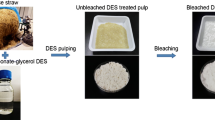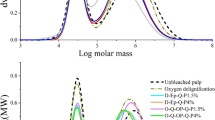Abstract
The effect of using auto pre-hydrolysis liquor, acidic pre-hydrolysis liquor, and alkaline pre-hydrolysis liquor on the production of alpha cellulose from poplar was investigated across this research work. Poplar chips were pulped with soda-AQ pulping process at a kappa number of 15 after being pre-hydrolyzed with different pre-hydrolysis liquors at 170 °C. The residual lignin of chips were more delignified by about 40% using a single stage oxygen delignification and totally bleached with a D0ED1 bleaching sequence. The results indicated that the yield and kappa number of the pulps can be affected by the kind of pre-hydrolysis liquor. In general, using acidic and alkaline catalysts in pre-hydrolysis liquor led to an acceleration in the rate of hemicellulose separation and kappa number reduction. The alkaline pre-hydrolysis and auto pre-hydrolysis had the highest and the least efficiency to remove hemicelluloses from the wood and purify the produced alpha cellulose, respectively. The alkaline pre-hydrolyzed dissolving pulp of poplar due to existing alkali catalyst in the pre-hydrolysis liquor and occurring alkaline darkening had the least brightness, while the acidic pre-hydrolyzed dissolving pulp, because of the effect of acidic catalyst on the reduction of chromophore compounds, had the highest brightness among the pulps. The results illustrated that a dissolving pulp with more purity and alpha-cellulose content is achievable from Poplar through employing an alkaline pre-hydrolysis stage, soda-AQ pulping, and OD0ED1 bleaching sequence.



Similar content being viewed by others
References
Al-Dajani WW, Tschirner U (2007) Alkaline extraction of hemicelluloses from aspen chips and its impact on subsequent kraft pulping. TAPPI 2:958–966
Alén R (2000) Basic chemistry of wood delignification. In: Stenius P (ed) Forest products chemistry. Papermaking science and technology series. Fapet Oy, Helsinki, pp 59–104
Alfaro A, Rivera A, Perez A, Yanez R, Garcıa JC, Lopez F (2009) Integral vaporization of two legumes by autohydrolysis and organosolv delignification. Biores Technol 100(1):440–445
Behin J, Mikaniki F, Fadaei Z (2008) Dissolving pulp (alpha-cellulose) from corn stalk by kraft process. Iran J Chem Eng 5(3):14–28
Browning BL (1967) Methods of wood chemistry, vol II. Wiley Interscience, New York, pp 377–414
Edward L (1985) Prehydrolysis of hardwoods with dilute sulfuric acid. Ind Eng Chem Prod Res Dev 24(4):614–623
Fernandes Diniz JMB, Gil MH, Castro JAAM (2004) Hornification-its origin and interpretation in woods pulps. Wood Sci Technol 37:489–494
Gehmayr V, Schild G, Sixta H (2011) A precice study on the feasibility of enzyme treatment of a kraft pulp for viscose application. Cellulose 18:479–491
Hillman D (2006) Do dissolving pulps really dissolve? Paper Asia, pp 12–18
Ibarra D, Kopcke V, Ek M (2009) Exploring enzymatic treatment for the production of dissolving grade pulp from different wood and non-wood paper grade pulps. Holzforschung 63:721–730
Ibarra D, Kopcke V, Ek M (2010) Behavior of different monocomponent endoglucanases on the accessibility and reactivity of dissolving-grade pulps for viscose process. Enzyme Microb Techn 47:355–362
Jahan MS (2009) Studies on the effect of prehydrolysis and amine in cooking liquor on producing dissolving pulp from jute (Corchorus capsularis). Wood Sci Technol 43:213–224
Jahan MS, Ahsan L, Noori A, Quayyum MA (2008) Process for the production of dissolving pulp from Trema orientalis (Nalita) by prehydrolysis kraft and soda-ethylenediamine (EDA) process. BioResources 3(3):816–826
Jahan MS, Sarkar M, Rahman MM (2015) Sodium carbonate pre-extraction of Trema orientalis in the production of paper grade pulp. Drewno 58(195):69–78
Köpcke V (2010) Conversion of wood and non-wood papergrade pulps to dissolving-grade pulps. Doctoral thesis, Royal Institute of Technology, School of Chemical Science and Engineering, Department of Fibre and Polymer Technology, Division of Wood Chemistry and Pulp Technology, Stockholm
Kordsachia O, Roßkopf S, Patt R (2004) Production of spruce dissolving pulp with the prehydrolysis-Alkaline sulfite process (PH-ASA). Linzinger Berichte 83:24–34
Laine C, Asikainen S, Talja R, Stepan A, Sixta H (2016) Simultaneous bench scale production of dissolving grade pulp and valuable hemicelluloses from softwood kraft pulp by ionic liquid extraction. Carbohyd Polym 136:402–408
Leschinnsky M, Sixta H, Patt R (2009) Detailed mass balances of the autohydrolysis of Eucalyptus globulus at 170 °C. BioRes. 4(2):687–703
Li G, Fu S, Zhou A, Zhan H (2015) Improved cellulose yield in the production of dissolving pulp from Bamboo using acetic acidic in prehydrolysis. BioResources 10(1):877–886
Liden J, Ohman LO (1997) Redox stabilization of iron and manganese in the +II oxidation state by magnesium precipitates and some anionic polymers: Implications for the use of oxygen-based bleaching chemicals. J Pulp Pap Sci 23:193–199
McDonough TJ, Uno S, Rudie AW, Courchene CE (2009) Optimization of ECF bleaching of kraft pulp: II. Effects of acid prehydrolysis on hardwood pulp bleachibility. TAPPI J 8(8):10–18
Mosier NS, Hendrickson R, Brewer M, Ho N, Sedlak M, Dreshel R, Welch G, Dien BS, Ade Ladisch MR (2005) Industrial scale-up of pH-controlled liquid hot water pre-treatment of corn fiber for fuel ethanol production. Appl Biochem Biotechnol 125:77–97
Niu W, Molefe MN, Frost JW (2003) Microbial synthesis of the energetic material precursor 1,2,4-butanetriol. J Am Chem Soc 125:12998–12999
Rath RL, Bhattacharjee C, Jain S, Bhattacharya PK (2005) Treatment of prehydrolysis liquor from pulp mill using a biological route followed by reverse osmosis. Chem Eng Technol 28(10):1201–1211
Saeed A, Jahan MS, Li H, Liu Z, Ni Y, van Heiningen A (2012) Mass balances of components dissolved in the pre-hydrolysis liquor of kraft-based dissolving pulp production process from Canadian hardwoods. Biomass Bioenergy 39:14–19
Samuelson O (1994) Optimized oxygen bleaching of kraft pulp threated with nitrogen dioxide. TAPPI J 77:127–133
Schild G, Sixta H (2011) Sulfur-free dissolving pulps and their application for viscose and lyocell. Cellulose 18:1113–1128
Sixta H (2006a) Pulp purification. In: Handbook of pulp. Wiley-VCH Verlag GmbH & Co. KGaA, Weinheim, pp 933–966
Sixta H (2006b) Handbook of pulp. Wiley-VCH, Weinheim, pp 325–365
Sixta H, Harms H, Dapia JC, Puls J, Saake B, Fink H-P, Roder T (2004) Evaluation of new organosolv dissolving pulps. Part I: preparation, analytical characterization and viscose processability. Cellulose 11:73–83
Sjogren B, Hook J (2000) Extended oxygen delignification—the effect of pretreatments and process conditions. In: International pulp bleaching conference, vol 242
Svenson DR, Jameel H, Chang H, Kadla JF (2006) Inorganic reactions in chlorine dioxide bleaching of softwood kraft pulp. J Wood Chem Technol 26:210–213
Tunc MS, Lawoko M, Heiningen AV (2010) Understanding the limitations of removal of hemicelluloses during autohydrolysis of a mixture of southern hardwoods. BioResources 5(1):356–371
Ulrich SH (1998) Chemical demand in ECF bleaching of eucalyptus pulp with extended prebleaching. In: Papers 1st ABTCP pulping technilogies conference, Saopaulo
Wan Rosli WD, Leh CP, Zainuddin Z, Tanaka R (2003) Optimization of soda pulping variables for preparation of dissolving pulp from oil palm fibre. Holzforchung 57:106–113
Weingarten R, Cho J, Conner WC, Huber GW (2010) Kinetics of furfural production by dehydration of xylose in a biphasic reactor with microwave heating. Green Chem 12:1423–1429
Xing R, Qi W, Huber GW (2011) Production of furfural and carboxylic acidics from waste aqueous hemicellulose solutions from the pulp and paper and cellulosic ethanol industries. Energy Environ Sci 4:2193–2205
Yoon SH, van Heiningen A (2008) Kraft pulping and papermaking properties of hot-water pre-extracted loblolly pine in an integrated forest products biorefinery. TAPPI J 7:22–27
Zhang H, Yung RA (2011) Effect of hot water pre-extraction on alkaline pulping and properties of wheat straw. Adv Mater Res 236–238:1174–1177
Author information
Authors and Affiliations
Corresponding author
Rights and permissions
About this article
Cite this article
Nikkhah Dafchahi, M., Resalati, H., Saraeyan, A.R. et al. Exploring the influence of initial liquor pH in the pre-hydrolysis stage on alpha-cellulose production from poplar. Cellulose 25, 4783–4790 (2018). https://doi.org/10.1007/s10570-018-1882-4
Received:
Accepted:
Published:
Issue Date:
DOI: https://doi.org/10.1007/s10570-018-1882-4




